Texts nos. 1-19
Browse the RIAo Corpus [http://oracc.museum.upenn.edu/riao/pager/]
01 02 03 04 05 06 07 08 09 10 11 12 13 14 15 16 17 18 19
01
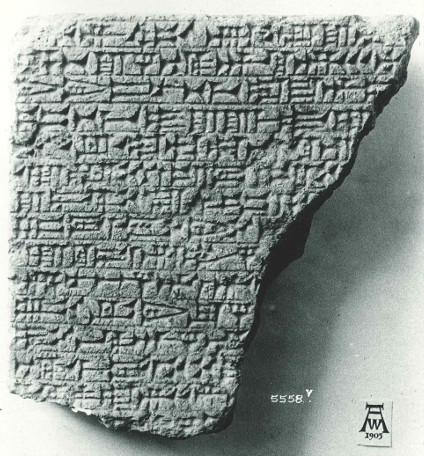
ex. 11 Ist EȘEM - (Ass 05558). For and image of the reverse side of this tablet, see text no. 2.
This text is an edition of a standard introduction common to many of Adad-nerari's inscriptions. Similar editions also follow text no. 2, a standard text of conclusions, and text no. 3, a second type of introduction. Therefore, texts no.1-3 should not be considered composite texts of full inscriptions, which start from text no. 4. When they share such standard introductions and conclusions, the present edition of Adad-nerari's inscriptions provides, like RIMA 1, only the central section of the texts with a reference to the corresponding text section at the beginning and/or at the end of the manuscript.
Text no. 1 is shared by the following inscriptions: texts no. 7-8, 10 (used here as the master text), 13, 16 and 19-20. These texts all also share the standard conclusion edited here below as text no. 2. These are the numbers of composite texts, each of which can have more exemplars. For example, the present text has been found on thirty-four different exemplars, among which, e.g., there are three exemplars of text no. 7.
The text begins by introducing the ruler with his religious and warlike epithets, and provides a complete overview of his conquests. A series of shorter lists of epithets and conquests is also attributed to his predecessors, Arik-din-ili, Enlil-narari and Aššur-uballiṭ I. Each of these rulers are given a final epithet which is only attested in the inscriptions of Adad-nerari I, underlining the importance given to territorial expansion from the beginning of the Middle Assyrian period: murappiš miṣri u kudurri. Three passages from the text can be included or not in each exemplar. These are:
Access the composite text [http://oracc.museum.upenn.edu/riao/Q005738/] of Adad-nārārī I 01.
Bibliography
02
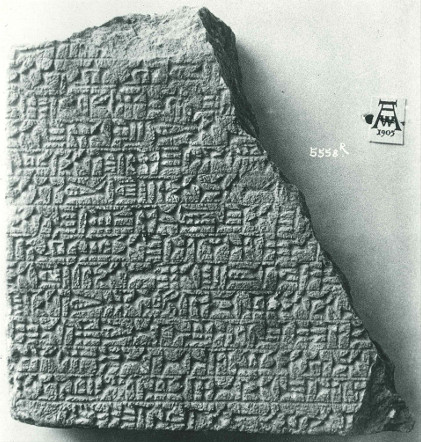
ex. 21 Ist EȘEM - (Ass 05558). For the obverse of the tablet, see text no. 1
As explained in the introduction to text no. 1, this text forms a standard conclusion shared by many of the inscriptions of Adad-nerari I. In particular, this conclusion section is found in the following texts: nos. 5-8, 10 (used here as the master text), 13, 16 and 19-20, 22, and 24. These inscriptions share also one of the two standard introductions, 1 and 3
Access the composite text [http://oracc.museum.upenn.edu/riao/Q005739/] of Adad-nārārī I 02.
Bibliography
03
This is an edition of a second introduction-type that, like text no. 01, is shared by more than one inscription. Texts nos. 4-6 and 22 have this introduction, and all of them except text no. 4, share the standard conclusion section, text no. 2.
Access the composite text [http://oracc.museum.upenn.edu/riao/Q005740/] of Adad-nārārī I 03.
Bibliography
04
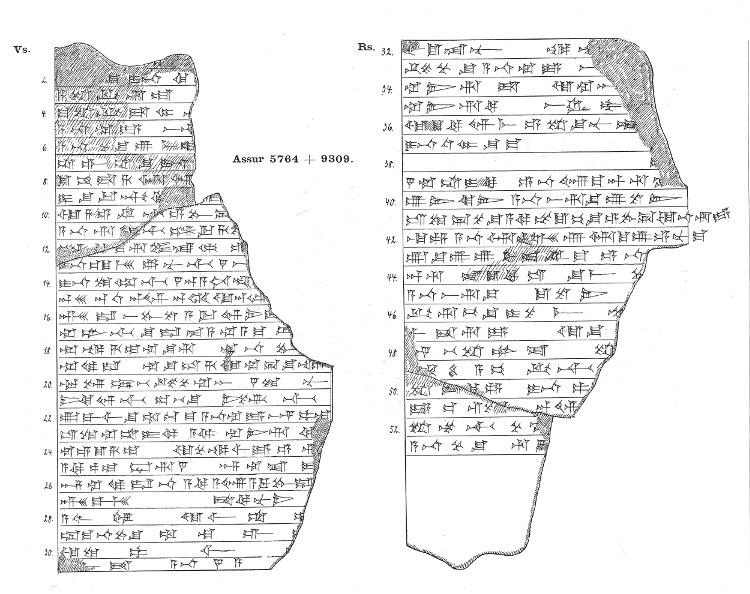
Weidner, AfO 5 pp. 89-100
A stone slab found in Aššur, but most probably carved to be shipped to the city Taidu. The inscription has an introductory section that is identical with the standard text no. 3, while its concluding section is similar but not identical to text no. 2. A blank space in lines 37b-38 was left to be filled later with the name of the structure, after its arrival in Taidu.
Access the composite text [http://oracc.museum.upenn.edu/riao/Q005741/] of Adad-nārārī I 04.
Bibliography
05
A stone cylinder fragment from Aššur bears an inscription recording some works on wells. The text is badly preserved, but the introduction and conclusion have been identified as exemplars of the standard texts nos. 3 and 2.
Access the composite text [http://oracc.museum.upenn.edu/riao/Q005742/] of Adad-nārārī I 05.
Bibliography
06
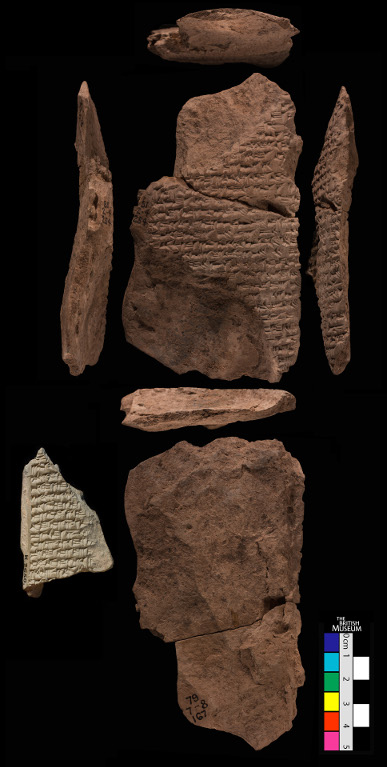
BM 1879-07-08, 0167 + 1881-02-04, 0254 (+) K 02650.
To
enlarge the picture, go to the correspondent cdli page [https://cdli.ucla.edu/dl/photo/P451864.jpg]
This text was found on two clay tablet fragments (1879-07-08, 0167 + 1881-02-04, 0254; E. Reiner has suggested that these two fragments were originally joined together) plus a third fragment (K 02650) that, although not a clear join, seems to come from the same tablet. The inscription records building operations for the Assyrian Ištar. This edition's introduction and conclusion are thought to be exemplars of texts nos. 3 and 2.
Access the composite text [http://oracc.museum.upenn.edu/riao/Q005743/] of Adad-nārārī I 06.
Bibliography
07
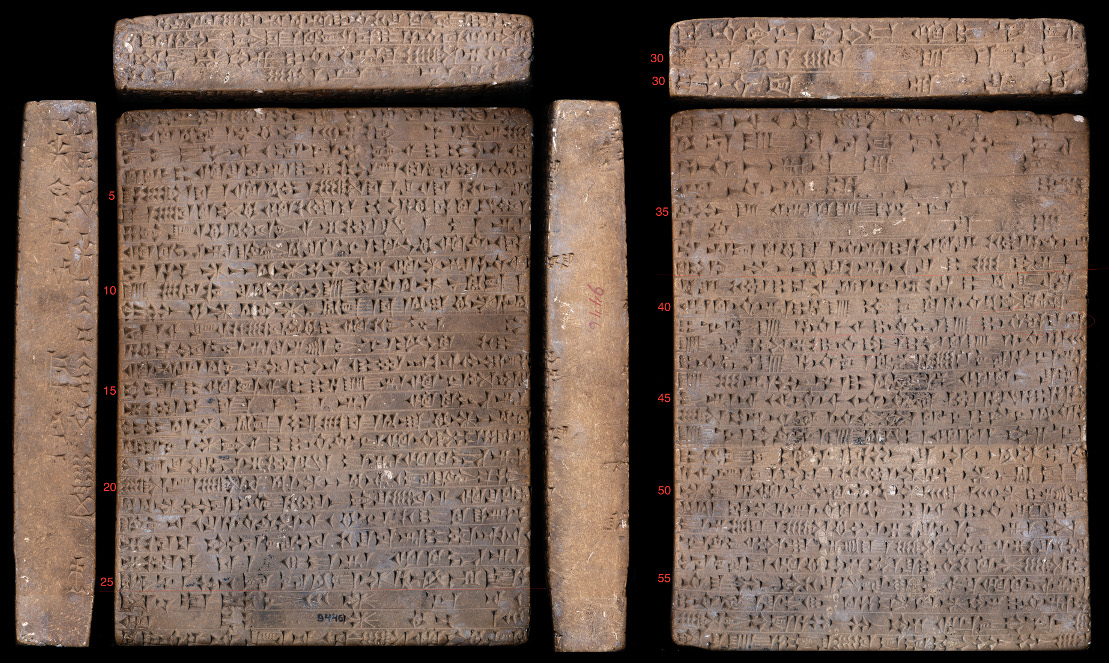
CBS 09446 (ex. 2). To enlarge the picture, go to the correspondent cdli page [https://cdli.ucla.edu/dl/photo/P264815.jpg]
This text is inscribed on three exemplars of stone tablets from Aššur recording construction work on the Step Gate (Mušlalu) of the city. In this edition, the introduction and conclusion correpond to exemplars of the standard texts nos. 1 and 2 respectively.
Access the composite text [http://oracc.museum.upenn.edu/riao/Q005744/] of Adad-nārārī I 07.
Bibliography
08
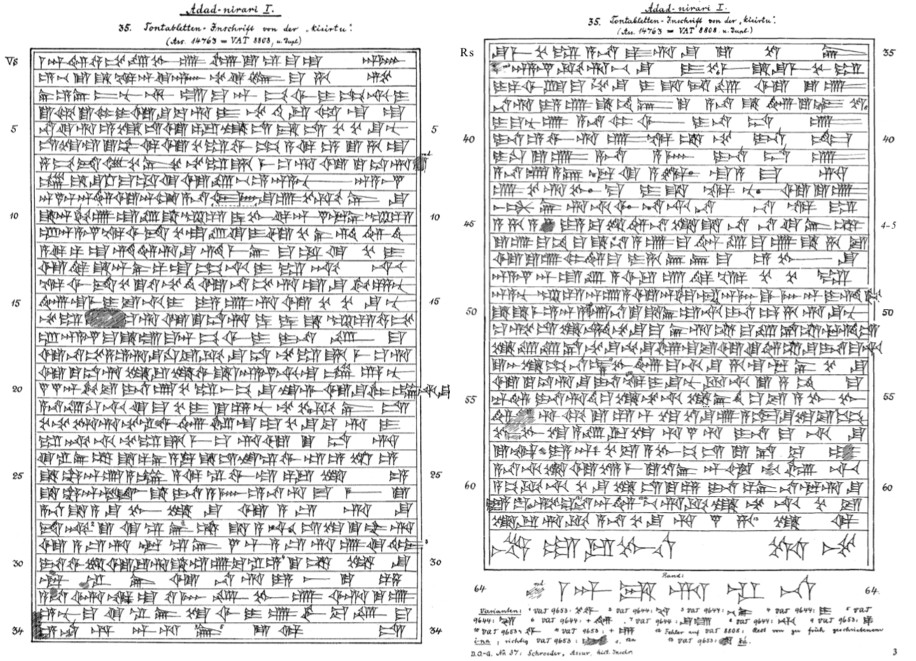
Messerschmidt, KAH 1 no. 65 (ex. 2)
A text on three clay tablets records the reconstruction of the quay wall facing the Tigris on the east side of the city Aššur. All three texts where found at Aššur, and ex. 1 was found in the quay wall itself.
Access the composite text [http://oracc.museum.upenn.edu/riao/Q005745/] of Adad-nārārī I 08.
Bibliography
09
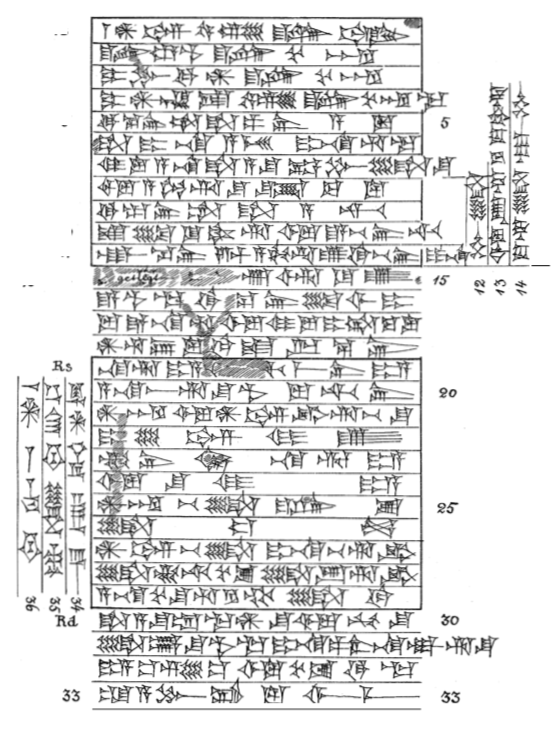
Schroeder, KAH 2 no. 33
Like for text no. 8, this inscription records the reconstruction at Aššur of the quay wall on the east side of the city, facing the Tigris. However this inscription is engraved on a stone object, whereas the exemplars of text no. 8 are all clay tablets.
Access the composite text [http://oracc.museum.upenn.edu/riao/Q005746/] of Adad-nārārī I 09.
Bibliography
10
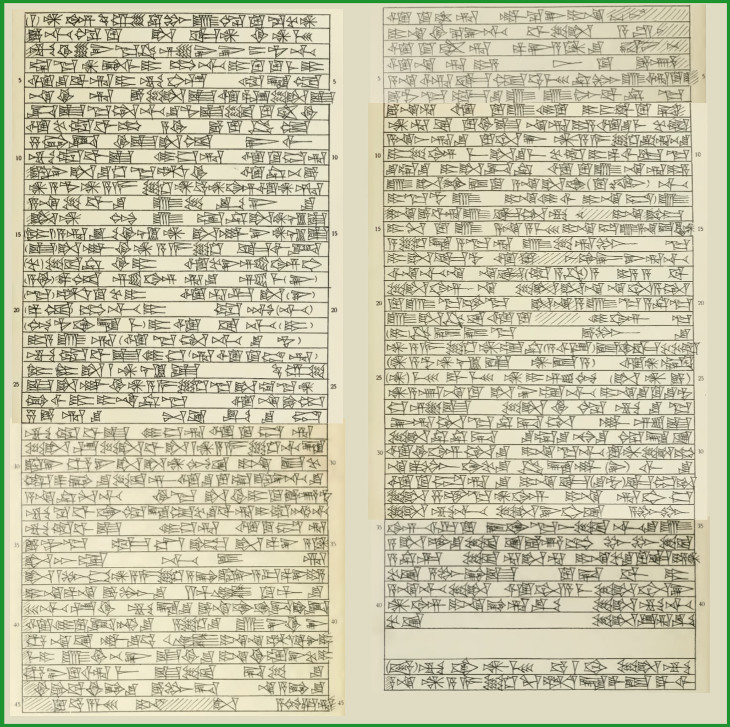
Ist A 00030 (Ass 01204). Messerschmidt, KAH 1 no. 3
A clay tablet from Aššur bears an inscription recording one of the two restoration works led by Adad-nerari I on the wall of the New City of Aššur (see also text no. 13). Weidner regarded VAT 9556 (ASS 14873) as an exemplar of the same inscription, particularly on the basis of the similar use of archaic script. Both in Grayson RIMA 2 and here, however, this text is catalogued as text no. 1 ex. 9.
Access the composite text [http://oracc.museum.upenn.edu/riao/Q005747/] of Adad-nārārī I 10.
Bibliography
11
This text describes work on the northern quay wall facing the branch of the Tigris which acted as a moat on this boundary of the city. The whereabouts of the three exemplars of this text are unknown (ex. 2 is known to be in Berlin, but no museum no. is available).
Access the composite text [http://oracc.museum.upenn.edu/riao/Q005748/] of Adad-nārārī I 11.
Bibliography
12
The restoration of a quay wall is also the subject of this inscription, known from one exemplar, the location of which is currently unknown.
Access the composite text [http://oracc.museum.upenn.edu/riao/Q005749/] of Adad-nārārī I 12.
Bibliography
13
A stone tablet from Aššur records one of the two restorations conducted by Adad-nerari I on the wall of the New City of Aššur (see also text no. 11. Weidner and Messerschmidt consider Ass 871 (EȘEM 06876) to be a duplicate of this text, but in both Grayson RIMA 2 and here this text is treated as ex 8 and 20 of texts nos. 1 and 2 (Note that Messerschmidt's copy of the inscription, KAH 1 no. 4, is a patchwork of both tablets).
Access the composite text [http://oracc.museum.upenn.edu/riao/Q005750/] of Adad-nārārī I 13.
Bibliography
14
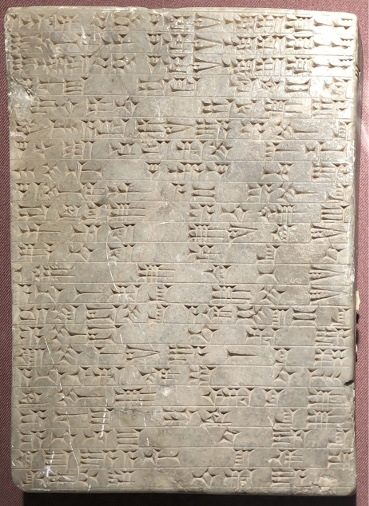
IM - (photo: K. Radner)
Two stone tablets from Aššur bear the same text describing works on the wall of the Inner City at Aššur.
Access the composite text [http://oracc.museum.upenn.edu/riao/Q005751/] of Adad-nārārī I 14.
Bibliography
15
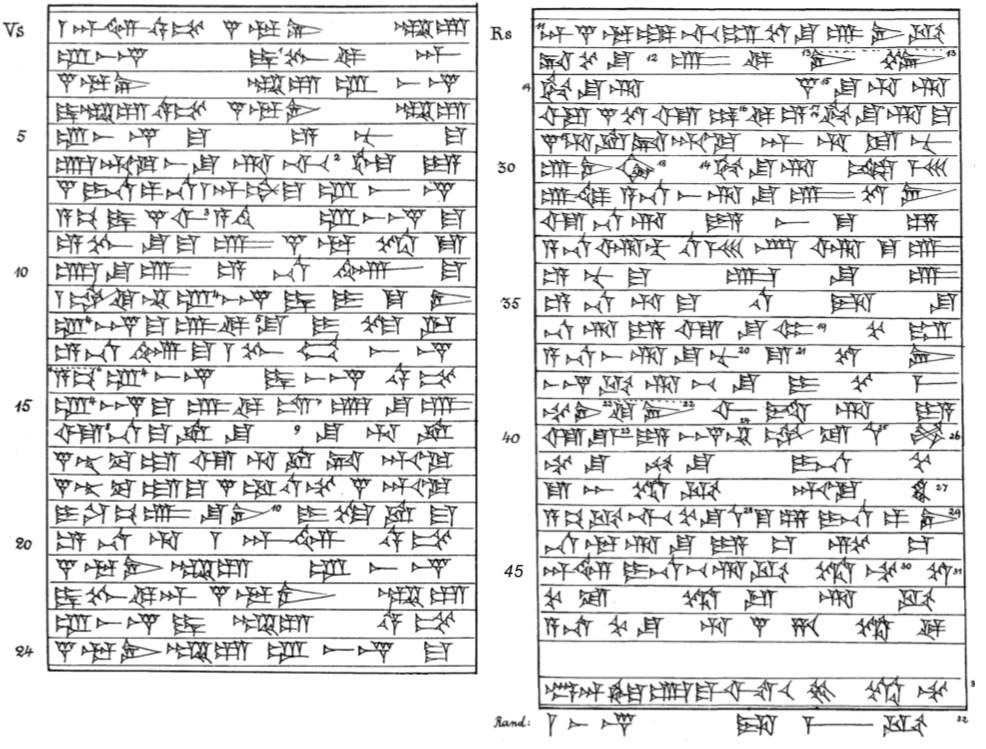
KAH 2 no. 34 (exs. 1-5, copy)
Several stone tablets from Aššur bear the same text describing work on the Assyrian temple of Ištar, and exemplars 1-5 were found stored in a niche in the back wall of the cella of this temple. The text describes two phases of reconstruction, the second one including work on the shrine of goddess Išḫara. Five of these exemplars were found by Adad-nerari's son, Shalmaneser I, who also restored the temple and modeled his inscription (text no. 8 [/riao/Q005796/]) after them. However, it was only Adad-nerari's grandson, Tukuti-Niniurta I (text no. 11 [/riao/Q005847/]), who finished the restoration work and redeposited the stone tablets in their original place.
Access the composite text [http://oracc.museum.upenn.edu/riao/Q005752/] of Adad-nārārī I 15.
Bibliography
16
The works on the palace of Aššur are recorded in two stone tablets discovered in the city
Access the composite text [http://oracc.museum.upenn.edu/riao/Q005753/] of Adad-nārārī I 16.
Bibliography
17
This text was engraved on a door socket discovered at Aššur and it concerns the work on the Anu-Adad Gate.
Access the composite text [http://oracc.museum.upenn.edu/riao/Q005754/] of Adad-nārārī I 17.
Bibliography
18

Ist EȘEM 06701 (Ass 01069)
Forthcoming
Access the composite text [http://oracc.museum.upenn.edu/riao/Q005755/] of Adad-nārārī I 18.
Bibliography
19
A stone fragment from Aššur inscribed with a text recording work on a quay wall similar to the one mentioned in texts no. 8-9, 12 and 20, but whose location is still unknown.
Access the composite text [http://oracc.museum.upenn.edu/riao/Q005756/] of Adad-nārārī I 19.
Bibliography
Nathan Morello
Nathan Morello, 'Texts nos. 1-19', The Royal Inscriptions of Assyria online (RIAo) Project, The RIAo Project, a sub-project of MOCCI, 2022 [http://oracc.museum.upenn.edu/riao/thekingdomofassyria13631115bc/adadnararii/texts119/]